Kobayashi Maru Variant of Star Trek 3-D Chess
I've been a great fan of Star Trek since it first aired when I was young. Over the years, I have seen this tri-dimensional chess game featured on several of both the old and new episodes.
I have search many places for coherent rules but none reflected the type of play presented by the actions of the characters during the scenes which featured gameplay. Movement of the pieces between the fixed boards and movement of the smaller 'attack' boards.
I recall one episode in which Spock, or was it Kirk?, moves a piece from a lower fixed board to an 'attack' board located above the upper fixed level. I also recall an episode in which a player re-orients an 'attack' board and re-loads it with pieces.
From this I began to visualize potential rules for the movement of pieces and 'attack' boards.
I present here my version. There may be similarities to others and I offer my apologies. I assure the reader that every rule was carefully considered by myself and tested for playability.
PLAYING FIELD
The regulation Star Fleet Chess set consists of three 4x4 fixed boards, arranged one above another and staggered so that the first rank of each higher level is exactly above the third rank of each lower lever.

The upper fixed level is referred to as the Black(B) level, the center fixed level is Neutral(N) and the lowest level is White(W).
In addition, there are four 2x2 attack platforms, which can be suspended both either above or below any of the four corners of the fixed levels. This is done in such a way as to place one square on the attack platform either directly above or below the corner square of the exact color on the fixed level.
The initial set-up points for the attack platforms are two above the fourth rank of B level and two below the first rank of W level.

These are to be the coordinates of each attack platform and fixed level:

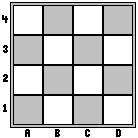
The attack platform below [W]A1 will be referred to as White Queen's Attack(WQA). The one below [W]D1 is White King's Attack(WKA).
The one above [B]A4 is Black Queen's Attack(BQA) and the one above [B]D4 is Black King's Attack(BKA).
These titles for the attack platforms will remain with them, regardless of placement, orientation or possesion during the game. It would be wise to mark each platform; black Q for BQA, white Q for WQA, black K for BKA and white K for WKA.
INITIAL SET-UP

White moves first.
MOVEMENT
Moves consist of relocating an individual piece or an entire attack platform with its contents.
PIECE MOVEMENT
Each piece moves upon the fixed levels according to their standard move rules. These will be restated for purpose of clarification.
MOVEMENT UPON FIXED LEVELS
Pawn
Moves normally one space forward orthogonal and captures only at the forward diagonals. The player may move the Pawn two spaces forward orthogonal on its first move. En Passant rules apply to such a two space move.
When the White Pawn reaches the fourth rank of B level or the Black Pawn reaches the first rank of W level, they are promoted to either a Rook, Knight, Bishop or Queen. There is also another method of promotion which will be mentioned in Attack Platform Movement.
Knight
Moves orthogonally two square then one more orthogonal in another direction OR orthogonally one square then two more orthogonal in another direction. It jumps all squares and can capture on the final.
Rook
Moves orthogonally any number of vacant squares and can capture on the final.
Bishop
Moves diagonally any number of vacant squares and can capture on the final.
Queen
Moves orthogonally or diagonally any number of vacant squares and can capture on the final.
King
Moves and captures orthogonally or diagonally one square. It may not be moved onto an attacked square.
MOVEMENT UPON ATTACK PLATFORMS
Since the Attack Platform consist of only a 2x2 playing field, movement upon the platform is very restrictive.
Each piece moves upon the platform according to it individual move strictures. Obviously, the Knight cannot move and remain upon a single Attack Platform unless there are two adjacent Attack Platforms. Example, an Attack Platform below [N]A1 and an Attack Platform above [W]A1 are considered adjacent and thus a proper Knight move may be preformed.
MOVEMENT FROM FIXED LEVELS TO ATTACK PLATFORMS and FROM ATTACK PLATFORMS TO FIXED LEVELS
This the most divisive area of previous rules. Let us agree that the purpose of the Attack Platform is to both transfer pieces from one fixed level to another fixed level and develop a significant force for use during the Attack Platform Movement.
Pawn
The White Pawn may move only in an upward orthogonal, it may capture at the diagonal but the change in attitude must be upward. Conversely, the Black Pawn must change attitude downward. Obviously, at the set-up, the White Pawn at [WQA]A2 is unable to make any non-capturing move, it does however attack [W]A2.
The White Pawn at [WQA]B2 may move to [W]A1, when vacated. It does not attack [W]A2 but does attack [W]B2. This blindspot is of strategic value and is similar to the normal blindspots of the two dimensional Pawn.
This apparent restrictive movement of the Pawn is resolved within the movement of the Attack Platforms.
Knight
Although the Knight can jump, it must move only through orthogonally connected spaces. At set-up, the White Knight at [WQA]B1 can be moved, it can move up one level and forward two spaces to [W]A2. It cannot move upon its Attack Platform. If an Attack Platform was placed above [W]A1 then the White Knight at [WQA]B1 may move to A1 and B2 of that particular platform.
If the [WQA] was located above [W]A4 then the following squares would be available to the White Knight located at [WQA]B1: [W]A2, [W]C4, [N]A4, [N]C2.
If the Knight was located at [W]D4 and an Attack Platform was at [W]D4u then it could move to [N]C2 and [N]D3.
If the Knight was located at [W]D2 and an Attack Platform was at [N]D1d then it could move to [N]D1.
Rook
The Rook may only move either directly up or down when changing levels. So at set-up, the White Rook at [WQA]A1 cannot change levels. It must either be moved to [WQA]B2 or the entire WQA platform must be relocated and the Rook moved to either [WQA]B1 or [WQA]B2.
If the Rook was located at [B]D1 and Attack Platforms were located at [N]D1d and [W]D4u then the following squares would be available: [N]D3 and the A2 of [N]D1d platform and the A2 of the [W]D4u.
Bishop
The Bishop may only move one level up or down. Any other movement would involve changing directions, a situation contrary to fair play in Chess.
Example:
If there was an Attack Platform at [W]A4u then a Bishop at [W]B3 may move to B1 of the Attack Platform. If the Bishop was at [W]A4 then it could move to A2 of the Attack Platform. If the Bishop was at B2 of the Attack Platform, it could move to [W]B4, [N]B2 and [N]B4.
Queen
The Queen combines the powers of the Bishop and the Rook, of course.
King
The King may make one single move similar to the Bishop or Rook, of course.
MOVEMENT FROM FIXED LEVEL TO FIXED LEVEL
All movement to and from Fixed levels is accomplished utilizing the Attack Platforms. No piece may move from one Fixed level to another except by passing from or through an Attack Platform.
CASTLING
The standard rules to castling apply. The King and the target Rook cannot have been moved. In addition, the target Attack Platform must also have not been moved.
KING'S ATTACK CASTLE
With both the King's Bishop and King's Knight space vacant and not attacked, the player may move the King to the King's Knight space and the Rook to the King's Bishop space
QUEEN'S ATTACK CASTLE
The Queen, Queen's Bishop and Queen's Knight spaces must be vacant and not attacked. The player may move the King to the Queen's Knight space and the Rook to the Queen's Bishop space.
This should cover the movement of pieces upon, from and to Fixed levels and Attack Platforms.
ATTACK PLATFORM MOVEMENT
An Attack Platform may only be moved if occupied solely by the player and then only if occupied by royalty, the Rook, Knight, Bishop, Queen and King. Pawns cannot command an Attack Platform but can possess them, denying an opponent the movement of it.
Each Attack Platform remains on its side of the playing field. So that the Queen's Attacks will only be placed at A1 and A4 positions of the fixed boards and the King's Attacks will only be placed at D1 and D4 positions of the fixed boards. This maintains the symmetry of the playing field while offering various strategic aspects for controlling the Attack Platforms on each side of the playing field.
Each Attack Platform moves, according to its commander, within the Attack Platform points of its coresponding side.
The Attack Platform points of the King's side are thus:

The Attack Platform points of the Queen's side are thus:
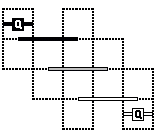
There are twenty-four points in all, twelve to each side of the playing field.

They called:
[B]A1u [N]A1u [W]A1u [B]A4u [N]A4u [W]A4u [B]A1d [N]A1d [W]A1d [B]A4d [N]A4d [W]A4d [B]D1u [N]D1u [W]D1u [B]D4u [N]D4u [W]D4u [B]D1d [N]D1d [W]D1d [B]D4d [N]D4d [W]D4d
ROOK-COMMANDED ATTACK PLATFORM MOVEMENT
An Attack Platform is considered Rook-commanded when there is the presence of a Rook and no enemy pieces on the platform. It may move in an orthogonal manner upon its appropriate side of the playing field. It can only move to and through adjacent and vacant Attack Platform Points. Thus the points at [B]A1u and [B]A4u are not considered adjacent and direct orthogonal movement between them is not allowed.
The Attack Platform Points which are orthogonally adjacent are:
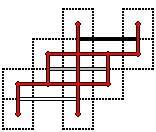
If a Rook-commanded Attack Platform was located at [N]D4d and the point at [N]D1d was occupied by the other Attack Platform, the Rook-commanded platform may move to [W]D4u but not to [W]D1u.
BISHOP-COMMANDED ATTACK PLATFORM
An Attack Platform is considered Bishop-commanded when there is the presence of a Bishop and no enemy pieces upon the platform. It may be move diagonally upon its appropriate side of the playing field. It can only move to and through adjacent and vacant Attack Platform Points.
The Attack Platform Points which are diagonally adjacent are:

If the Bishop-commanded platform is located at [W]A1d and [N]A1d is occupied by the other platform, the [B]A1d point is unavailable for the move.
KNIGHT-COMMANDED ATTACK PLATFORM
An Attack Platform is considered Knight-commanded when there is the presence of a Knight and no enemy pieces upon the platform. The platform may move on its appropriate side of the board and only to vacant Attack Platform points. It moves similar to the standard knight move but between the fixed levels. Thus it may move up one point and across two points or up two points and across one. It is not effected by occupied points between its start and destination.



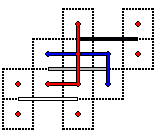

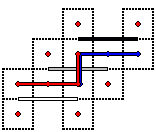
QUEEN-COMMANDED ATTACK PLATFORM
An Attack Platform is considered Queen-commanded when there is the presence of a Queen and no enemy pieces upon the platform. The platform may be moved according to the rules and restrictions of either the Rook-commanded or Bishop-commanded platform.

KING-COMMANDED ATTACK PLATFORM
An Attack Platform is considered King-commanded when there is the presence of the King and no enemy pieces upon the platform. The platform may be move one adjacent and vacant Attack Platform point either orthogonal or diagonal. As long as this does not leave the King in a state of Check.
This covers the Attack Platform Movement.
At set-up, each Attack Platform is considered both Rook-commanded and Knight-commanded and may move according to either piece as long as they are occupying the platform. Multiple royalty adds to the movement power of the Attack Platform.
So, an Attack Platform occupied by the King and, let us say, a Knight may move either as King-commanded or Knight-commanded.
Remember this, no Attack Platform may be moved by a player which is empty or occupied by any opponent pieces. Nor can two Attack Platforms occupy the same Point.
ENDGAME
Of course the goal of ST3d Chess is to checkmate the opponent's King. This can be accomplished in many ways. Strand the King on a fixed level, deny the opponent access and use of Attack Platforms, these are several basic strategies to a quick checkmate.
THE PROBLEM OF THE STRANDED PAWN ON EACH ATTACK PLATFORM
By now, the reader has surmised that normal movement of the outside Pawn on the Attack Platforms appears impossible. There are several potentials:
- The presence of this Pawn guarantees control of the Attack Platform.
- The Pawn stills maintains its ability to capture to the fixed levels.
- When the White-controlled Attack Platforms are moved to the [B]4u positions, all pawns on its second rank are immediately eligible for promotion. Likewise, when the Black-controlled Attack Platforms are moved to the [W]1d positions, all pawns on its first rank are immediately eligible for promotion.
- The Pawn may still move and attack to a future adjacent Attack Platform.
THE PROBLEM OF THE STRANDED PAWN ON THE FIXED LEVELS
The reader may also have noticed that the White Pawns in the second and third file of the fixed levels can be moved to the fourth rank, thus ending further progress. Not so, these Pawns can potentially attack a square on an Attack Platform located at the fourth rank.
Example: With an Attack Platform located at [W]D4u, a White Pawn located at [W]C4 will attacks its A2 square. This could potential force an opponent to retreat or avoid such an Attack Platform placement.
Here we see the necessity of the En Passant capture.
Example: An Attack Platform with a Black Pawn located at its B1 location and a Knight located at B2 moves to the [W]A4u point. This sets up the potential of a future Attack Platform move to [W]A1d and thus becoming a direct threat on the White King. So White moves the B file Pawn to the fourth rank and threatens the Black Knight, thus initially denying Black the opportunity to capture it at the third rank. So En Passant, the Black Pawn move to [W]B3 and captures the White Pawn at [W]B4.
Another example of the En Passant capture in ST3d chess:
An Attack Platform with an umoved Black Pawn on B1 is located at [N]A4u, another Attack Platform is located at [N]A4d. [N]A4 and B1 of [N]A4d is vacant. A White Pawn has been just moved to [N]B3, so Black moves the Pawn at B1 of [N]A4u, two spaces through [N]A4 to B1 of [N]A4d, attempting to deny White the capture.
White may immediately reply with [N]B3 to [N]A4 and the capture of the Black Pawn at B1 of [N]A4d.
I hope the reader has found these rules enjoyable and of great assistance with their gameplay.
I am working up a composition about 'Strategies and Tactics in ST3d Chess' which I will post when finished.
Send all questions and comments to:
(email removed contact us for address) .net
This webpage is the product of L. Lynn Smith.
Written by . Web page posted by David Howe.
WWW page created: 21 Feb 2001. Last modified on: 21 Feb 2001.
